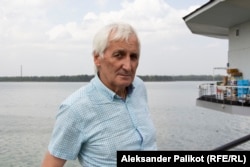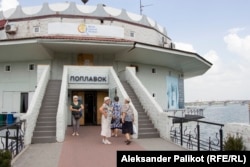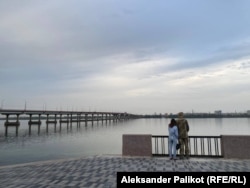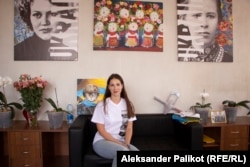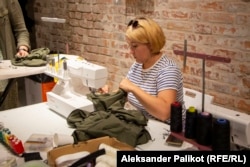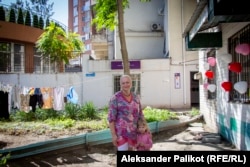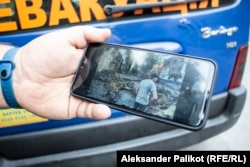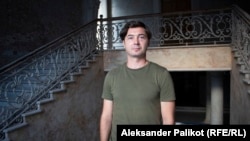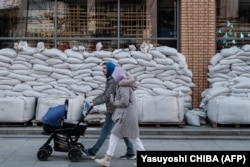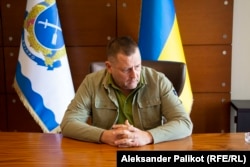DNIPRO, Ukraine -- When he fled his hometown in the Donbas for Dnipro, pensioner Dmytro Metyolkin left behind not only his past life but his memories, too.
"The only thing I regret is that I didn't take my personal computer with me -- I could have at least ripped the hard drive out of it," said Metyolkin, 77, who left Lysychansk just before it was captured by Russian forces in early July -- a key step in their still unsuccessful drive to control eastern Ukraine's Luhansk and Donetsk regions in their entirety.
Now the former factory worker and amateur photographer said trying to get the computer back would be too risky and expensive. He is unlikely to recover the archive of his life and the lives of loved ones -- thousands of photographs taken over decades of the turbulent 20th century and far into the 21st, which should have been calmer but -- with Russia's full-scale invasion – has turned calamitous in Ukraine.
"I kept the photos of the identification number tattooed on my mother's body in a Nazi concentration camp on that hard drive, and now I won't ever recall what the number was," he said, looking down at the wide Dnieper River -- Dnipro in Ukrainian -- which gives his new city its name.
Metyolkin had just left Poplavok, a restaurant in an iconic circular concrete building rising from the surface of the river, where volunteers have been giving free meals to people displaced by the war.
When Metyolkin first came to Dnipro he considered traveling on to Germany, where he has relatives: the family of his uncle, who had been deported there as a forced laborer during World War II. But after speaking with his cousins, he said, he understood there was no point in leaving Ukraine at his age.
The pensioner from Lysychansk is one of some 2,500 internally displaced persons (IDPs) who have been coming to Poplavok almost every day since it started to offer free meals in April. But the aid program is due to end within days due to a lack of financial resources, according to restaurant manager Olha Hubanova.
"There's an end to everything," said Metyolkin, who has been a regular visitor to the restaurant, before adding a reference to Russian President Vladimir Putin: "My only hope now is that that creep will be over soon, too."
'It's Awful To Turn People Down'
Dnipro -- located relatively close to the front line that arcs up from Kherson in the south, passes through the Donbas, and ends further north, near Kharkiv -- has been a key logistical and humanitarian hub for Ukraine since Putin launched a large-scale invasion on February 24. The influx of people from the Donbas as well as the Kharkiv, Kherson, and Zaporizhzhya regions has created a new reality visible in almost every corner in the city, whose population approached 1 million before the newcomers arrived.
At the end of August, the men fishing at the Dnieper's famous embankment and people picnicking on the adjacent green spaces seemed to be simply enjoying the last hot days of summer. In fact, though, like Metyolkin, many of them had just left behind their former lives, homes, and loved ones to escape the grinding war.
Olena, who did not want her last name published for reasons of privacy, had just come to Dnipro from occupied Kherson with her daughter. She had long hesitated to leave, she said, even though "the Russians were doing anything they wanted there." But when her daughter was called to go to school with a Russian curriculum, and when the long-awaited Ukrainian counteroffensive in the south started to gain traction, she decided to get out.
Olena shook as she recalled the bombardment of her neighborhood and the "filtration" process she endured as left the Kherson region. "There's one air-raid alarm after another here in Dnipro, but I am calming down for the first time since the war began," she said, sitting on a sunlit bench.
Over six months since the invasion turned the eight-year conflict simmering in the Donbas into a full-scale war, Dnipro, Ukraine's fourth-largest city, hosts as many as 130,000 IDPs, according to official data. This figure is probably even higher -- not everyone who has fled from areas under fire has registered. The city has also provided temporary shelter to hundreds of thousands of IDPs traveling further west or abroad.
According to Yulia Dmytrova, director of the Coordinating Headquarters of Dnipro Volunteers, an umbrella organization coordinating the work of numerous volunteer groups and initiatives, the huge volunteer movement does not lack for motivation or manpower and the municipal authorities have the humanitarian situation under control.
However, she said, most of the city's shelters are going to be closed before the heating season -- the fall, winter, and early spring months during which the state heats homes and buildings -- as they were initially expected to host IDPs only temporarily.
"Most displaced people either managed to find accommodation for themselves or decided to go abroad," Dmytrova said, adding that there are not enough resources to keep all the shelters working during the heating season.
"It's awful to turn down people who come here, but sometimes I have no other option," says Tetyana Bilyk, who runs a shelter close to the city center that was planned for 25 people but now hosts about 70.
The entrance to the Soviet high-rise building turned into a shelter was decorated with heart-shaped balloons. Bilyk, middle-aged women with short gray hair, was celebrating her birthday the day before she spoke to RFE/RL, and the residents -- most of whom call her Mama -- plotted a surprise party for her. "Some of them lost their families or loved ones. That's why they call me that," she said.
The stories of several of the shelter's residents are stories of lives torn apart. One woman came to Dnipro after giving birth in a basement and losing her husband in front of her child on the same day, Bilyk said. Another, in her 80s, came with soles tied to her shoes with a string and nothing but a passport clutched in her hand, her dog, and two puppies. Watching through a window as a man played with children in the yard, Bilyk said he had lost his home in a rocket attack a few days earlier: "He wept and said that he is now a tramp."
Bilyk says that for an increasing number of people, finding an apartment or even a spare room is close to impossible in the overcrowded city as rental rates rise.
"That's why we will keep this place open until the end of the war," she said, adding that the private companies whose donations keep it running have vowed to continue their support. "But we are the exception rather than the rule -- half of the shelters are already closed," she said.
According to Illya Borsuk, a volunteer who evacuates people from hot spots in the Donbas, the fear of being left alone after leaving one's home is the main reason why many people decide to stay put despite the risk.
"Most people who do evacuate decide to go only after a bombardment next to their house," he said, showing a fragment of a missile he just brought for the Dnipro Museum of the ATO -- the Anti-terrorist Operation, as the war in the Donbas is sometimes known.
Borsuk himself said he left his home in the Donetsk region town of Yenakiyeve back in 2014, the first year of the Donbas war, after Russia-backed forces identified him as a threat and tortured him in a school basement.
"It was a school that Yanukovych had attended in his childhood," Borsuk said, referring to the Moscow-friendly president whose downfall in February 2014, following the Euromaidan protests, preceded Russia's seizure of Ukraine's Crimean Peninsula and the outbreak of the Donbas war.
"He promised to renovate it, but it turned into a torture room instead," he said with a grim smile.
After the Russian invasion in February, Borsuk had to run again. Along with his wife and two daughters, he left Druzhkivka, also in the Donbas, and devoted himself to providing humanitarian aid and offering evacuation to people in war-torn or threatened areas.
"Russian propaganda is more and more prevalent there," he said, "because most of those who disbelieve it have already left."
But as sanitary conditions worsen and winter approaches, he hopes to get as many more people out as he can.
"My idée fixe is to come back to my home and look into the eyes of those who doubted our victory," he said.
New Identity
War can be easily felt on the streets of Dnipro. But unlike the places the IDPs here have fled, it's not because they are abandoned or destroyed.
Khaki-colored military pickups speed through the city center along with flashy sports cars and black-windowed SUVs. Disoriented newcomers carrying personal belongings in huge plastic bags rush to buses and trams between crumbling townhouses from the turn of the 20th century and Dnipro's landmark postmodern skyscrapers. Cafes and restaurants are filled with hip young people, agitated businessmen, and couples enjoying their time.
Dnipro is going through one of its many transformations as the war rages not far away. One of the wealthiest cities in Ukraine in terms of per-capita income, it was relatively prosperous even in the Soviet era, enjoying the status of a well-stocked "closed city" because of the strategic rocket industry. After the collapse of the Soviet Union, it produced some of the most prominent oligarchs -- tycoons with substantial sway in the country's affairs.
"There is no crisis in the city," said Andriy Palash, director of the Dnipro Center for Contemporary Culture, a popular artistic venue now transformed into a social hub for the integration of internally displaced people.
The cultural center, whose home was the headquarters of the regional administration in the era of the Russian Empire, now hosts several humanitarian and cultural organizations, some of which moved here from cities closer to the front line. It recently opened an exhibition of wartime art and holds concerts and other performances, as well as events such as art workshops and first aid training.
If Dnipro lacked anything in the recent past, Palash said, it was not money but ideas.
"In Soviet times, Dnipropetrovsk had a strong sense of a mission, a dream of conquering the cosmos -- and then nothing came to replace this idea," he said, using the Soviet-era name that the city dropped in 2016. "The active part of the society started to fill this empty space only during the Euromaidan period in 2014…. It was a period of creative freedom that opened a way for us getting more and more united around a new identity."
‘A Bone In The Throat'
It was also then that Dnipro earned the reputation of Ukraine's outpost. Despite the city's historical ties to Russia and a predominantly Russian-speaking population, the spread of the so-called Russian Spring -- unrest in the east and south of Ukraine fomented by Russia -- was halted in Dnipro. Live coverage of the Euromaidan protests in Kyiv was projected on the exterior wall of a central shopping mall and attempts by pro-Russian forces to shake up the situation in the city fell flat -- in some cases crushed in street fights.
Local elites also decisively backed what Ukrainians call the Euromaidan Revolution, or the Revolution of Dignity, in 2014. Tycoon Ihor Kolomoyskiy, who had been appointed as head of the administration for the region that includes Dnipro, subsidized the Ukrainian Air Force, backed the creation of a battalion that fought in the Donbas, and offered a $10,000 reward for the capture of a pro-Russian saboteur.
The current mayor, Borys Filatov, is a former business partner of Kolomoyskiy and was formerly his deputy responsible for internal policy.
"I cut all my contacts with Kolomoyskiy years ago and I have no clue about his whereabouts," Filatov said, smoking a cigarette in his private office, where he has been working since the Dnipro City Council started to operate online because of the threat of Russian attacks. "All I can say is that he is not supporting the city that made his multibillion wealth possible the way other entrepreneurs are."
Filatov has little patience for questions about Kolomoyskiy, who is under U.S. sanctions and reportedly had his Ukrainian citizenship revoked this summer in a decree from President Volodymyr Zelenskiy, though it's still unclear whether that is the case. But the Dnipro mayor's ties with the Ukrainian leadership are tense because of another move by Zelenskiy that outraged the local elite.
Filatov's long-time political ally Hennadiy Korban -- dubbed Dnipro's "shadow mayor" by media outlets -- had his citizenship revoked by the same decree, and his passport was confiscated at the border in July, according to Korban's lawyer Andriy Yosypov.
"The war with the external enemy has not been won yet, and the central authorities are already looking for internal enemies," Filatov said, adding that he no longer has direct contact with senior officials in Kyiv.
"Russian-speaking Dnipro playing the role of a stabilizing factor for the whole of Ukraine has been a bone in the throat for Russia," he said. "That's why the authorities in Kyiv should understand that local government cannot be just suppressed if it's not exactly what they would like it to be."
Meanwhile, Filatov said, the city is bracing for winter. The municipal warehouses are filled with food supplies, medicines, and other necessities. Many public buildings will be closed to save energy, and teaching in schools will take place online.
Dnipro, which has been pounded by Russian missiles repeatedly since the first days of the invasion, is preparing for possible attacks on the city's infrastructure.
"The apocalyptic scenario for us is the mass bombing of electricity grids and heating stations. I don't know what we'll do then, perhaps we'll just start burning wood -- we already ordered extra pot-belly stoves," Filatov said.
But Dnipro's mayor is confident his city will not be overrun, should there be a ground attack -- "We are digging the fifth line of defenses right now," he said -- and that it will never succumb to Moscow's authority regardless of tension in ties to Kyiv.
"It was never really a Russian city, but a multiethnic and multireligious community that strove for freedom and independence from everybody," he said.





